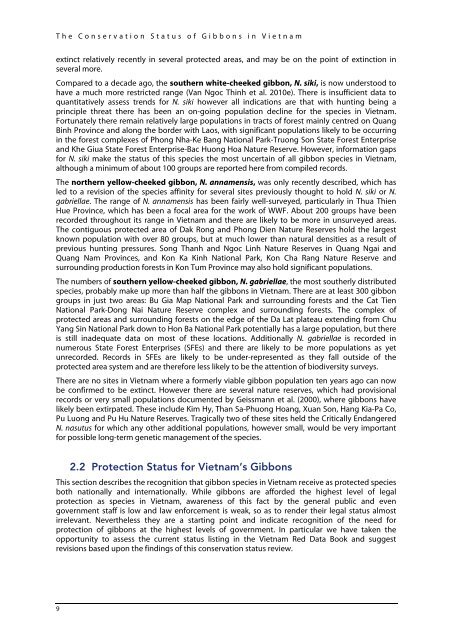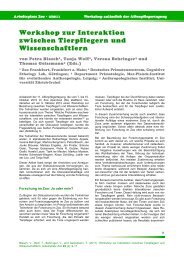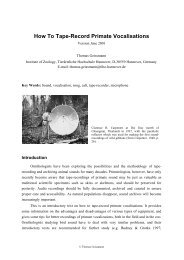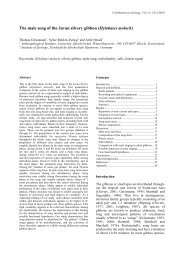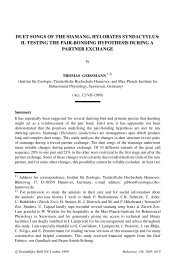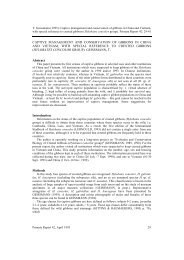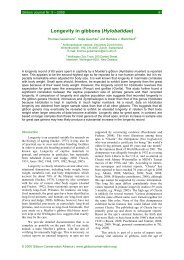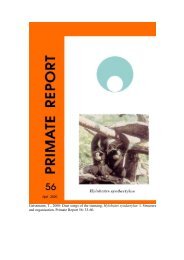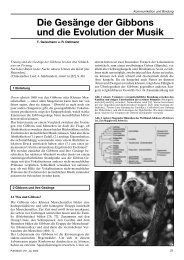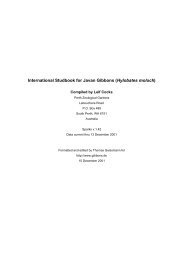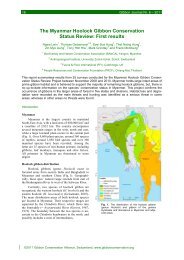<strong>The</strong> <strong>Conservation</strong> <strong>Status</strong> <strong>of</strong> <strong><strong>Gibbon</strong>s</strong> <strong>in</strong> <strong>Vietnam</strong>Generally the future for gibbons <strong>in</strong> <strong>Vietnam</strong> rema<strong>in</strong>s precarious, but the status <strong>of</strong> each gibbonvaries dramatically and there is a marked difference between northern and southern <strong>Vietnam</strong>. Formost sites there is <strong>in</strong>sufficient <strong>in</strong>formation to make a qualified judgement on a population trendover the past ten years, other than recognis<strong>in</strong>g that the presence <strong>of</strong> hunt<strong>in</strong>g is most likely to becaus<strong>in</strong>g population decl<strong>in</strong>es. Although, for about a quarter <strong>of</strong> sites reported here, a decl<strong>in</strong><strong>in</strong>ggibbon population has been demonstrated with certa<strong>in</strong>ty and the reality is probably that gibbonpopulations are decl<strong>in</strong><strong>in</strong>g at most sites. Here we will look at some <strong>of</strong> the general trends for eachspecies. For more details please refer to the relevant species chapters.<strong>The</strong> eastern black gibbon, N. nasutus, was rediscovered <strong>in</strong> 2002 on the border with Ch<strong>in</strong>a <strong>in</strong>Trung Khanh District, Cao Bang Prov<strong>in</strong>ce and conservation efforts at this site so far appear to bedemonstrat<strong>in</strong>g a gradual population recovery. This is the only location globally where this speciesis currently known to exist, although local extirpations <strong>in</strong> other areas may have occurred <strong>in</strong> thelast 10 years. Fortunately, at this location there have been very few records <strong>of</strong> hunt<strong>in</strong>g with gunsand no records <strong>of</strong> gibbons be<strong>in</strong>g hunted s<strong>in</strong>ce the population was discovered. N. nasutus has, thusfar, been turned around from the br<strong>in</strong>k <strong>of</strong> ext<strong>in</strong>ction both <strong>in</strong> <strong>Vietnam</strong> and globally follow<strong>in</strong>g itsrediscovery. It is the only gibbon species <strong>in</strong> <strong>Vietnam</strong> for which it can be said with any confidencethat there has been an <strong>in</strong>crease <strong>in</strong> population, but that is ma<strong>in</strong>ly due to the entire populationbe<strong>in</strong>g so small, about 19 groups (<strong>in</strong>clud<strong>in</strong>g groups <strong>in</strong> Ch<strong>in</strong>a), and entirely <strong>in</strong> one place so it can beeasily monitored, and conservation efforts can be very focussed.<strong>The</strong>re are few records <strong>of</strong> large gibbon population crashes occurr<strong>in</strong>g recently, but that may bemore as a result <strong>of</strong> lack <strong>of</strong> data, than the reality <strong>of</strong> the situation on the ground. <strong>The</strong> most closelymonitored gibbon populations <strong>in</strong> <strong>Vietnam</strong> are those <strong>of</strong> the western black gibbon, N. concolor,<strong>in</strong> the Hoang Lien Mounta<strong>in</strong> range, which overall have undergone a population decl<strong>in</strong>e greaterthan 50% s<strong>in</strong>ce surveys were first carried out <strong>in</strong> 2000 and 2001. At Hoang Lien-Van Ban NatureReserve, the gibbon population has dropped to a level where it is no longer viable and it ispossible that the Mu Cang Chai-Muong La population, slightly to the south, would haveundergone a similar decl<strong>in</strong>e without a concerted effort to protect them over the past ten years. Atthe latter location, follow<strong>in</strong>g a strong decl<strong>in</strong>e <strong>in</strong> the first half <strong>of</strong> the decade the population with<strong>in</strong>Mu Cang Chai Species and Habitat <strong>Conservation</strong> Area (SHCA), at least, appears to have stabilised.<strong>The</strong> experience <strong>of</strong> FFI work<strong>in</strong>g <strong>in</strong> the Hoang Lien Mounta<strong>in</strong>s should be a wake-up call for thecritical need for monitor<strong>in</strong>g when work<strong>in</strong>g on species-level conservation for gibbons or otherspecies. <strong>The</strong> population decl<strong>in</strong>e <strong>of</strong> this species, despite long-term conservation attention, isillustrative <strong>of</strong> the level <strong>of</strong> threat that gibbons are under <strong>in</strong> <strong>Vietnam</strong> generally.For both N. nasutus and N. concolor the mid- to long-term prospects for their survival <strong>in</strong> <strong>Vietnam</strong>are far from certa<strong>in</strong>, as they are both dependent upon the survival <strong>of</strong> s<strong>in</strong>gle small populations. <strong>The</strong>prospects for gibbons appear to improve as we proceed south through the country, and for each<strong>of</strong> the other crested gibbon species there is more than one site with a potentially viablepopulation.A revised assessment <strong>of</strong> the distribution <strong>of</strong> the northern white-cheeked gibbon, N. leucogenys,<strong>in</strong>dicates that it has a larger range than previously thought a decade ago, now extend<strong>in</strong>g furthersouth (Van Ngoc Th<strong>in</strong>h et al. 2010e). Dur<strong>in</strong>g recent years, survey work, ma<strong>in</strong>ly led by <strong>Conservation</strong>International (CI) and the Centre for Natural Resources and Environmental Studies (CRES), cannow give a much clearer picture <strong>of</strong> the status <strong>of</strong> this species <strong>in</strong> <strong>Vietnam</strong>. All significant recordscome from locations close or next to the Lao border and 79 groups have been reported s<strong>in</strong>ce2000. Throughout the country there may be at least 190 groups, <strong>of</strong> which most are currentlyknown from Pu Mat National Park which probably ma<strong>in</strong>ta<strong>in</strong>s about 130 groups. <strong>The</strong>se gibbons arenow restricted to remote border areas, where they appear to be protected by the harshmounta<strong>in</strong>ous terra<strong>in</strong>. This population is <strong>of</strong> global significance and may extend well <strong>in</strong>to Laos.Muong Nhe Nature Reserve and Vu Quang National Park, aga<strong>in</strong> both on the border with Laos, mayalso hold significant populations <strong>of</strong> conservation priority. <strong>The</strong> population <strong>of</strong> gibbons <strong>in</strong> Vu QuangNational Park and neighbour<strong>in</strong>g forests rema<strong>in</strong>s largely unknown and may be sizeable allow<strong>in</strong>g usto speculate that the population <strong>of</strong> this species <strong>in</strong> <strong>Vietnam</strong> could be as high as 300 groups.Nevertheless, at all locations populations <strong>of</strong> N. leucogenys appear to be <strong>in</strong> decl<strong>in</strong>e, largely due tohunt<strong>in</strong>g, exacerbated by land conversion and forest fragmentation. It is known to have gone8
<strong>The</strong> <strong>Conservation</strong> <strong>Status</strong> <strong>of</strong> <strong><strong>Gibbon</strong>s</strong> <strong>in</strong> <strong>Vietnam</strong>ext<strong>in</strong>ct relatively recently <strong>in</strong> several protected areas, and may be on the po<strong>in</strong>t <strong>of</strong> ext<strong>in</strong>ction <strong>in</strong>several more.Compared to a decade ago, the southern white-cheeked gibbon, N. siki, is now understood tohave a much more restricted range (Van Ngoc Th<strong>in</strong>h et al. 2010e). <strong>The</strong>re is <strong>in</strong>sufficient data toquantitatively assess trends for N. siki however all <strong>in</strong>dications are that with hunt<strong>in</strong>g be<strong>in</strong>g apr<strong>in</strong>ciple threat there has been an on-go<strong>in</strong>g population decl<strong>in</strong>e for the species <strong>in</strong> <strong>Vietnam</strong>.Fortunately there rema<strong>in</strong> relatively large populations <strong>in</strong> tracts <strong>of</strong> forest ma<strong>in</strong>ly centred on QuangB<strong>in</strong>h Prov<strong>in</strong>ce and along the border with Laos, with significant populations likely to be occurr<strong>in</strong>g<strong>in</strong> the forest complexes <strong>of</strong> Phong Nha-Ke Bang National Park-Truong Son State Forest Enterpriseand Khe Giua State Forest Enterprise-Bac Huong Hoa Nature Reserve. However, <strong>in</strong>formation gapsfor N. siki make the status <strong>of</strong> this species the most uncerta<strong>in</strong> <strong>of</strong> all gibbon species <strong>in</strong> <strong>Vietnam</strong>,although a m<strong>in</strong>imum <strong>of</strong> about 100 groups are reported here from compiled records.<strong>The</strong> northern yellow-cheeked gibbon, N. annamensis, was only recently described, which hasled to a revision <strong>of</strong> the species aff<strong>in</strong>ity for several sites previously thought to hold N. siki or N.gabriellae. <strong>The</strong> range <strong>of</strong> N. annamensis has been fairly well-surveyed, particularly <strong>in</strong> Thua ThienHue Prov<strong>in</strong>ce, which has been a focal area for the work <strong>of</strong> WWF. About 200 groups have beenrecorded throughout its range <strong>in</strong> <strong>Vietnam</strong> and there are likely to be more <strong>in</strong> unsurveyed areas.<strong>The</strong> contiguous protected area <strong>of</strong> Dak Rong and Phong Dien Nature Reserves hold the largestknown population with over 80 groups, but at much lower than natural densities as a result <strong>of</strong>previous hunt<strong>in</strong>g pressures. Song Thanh and Ngoc L<strong>in</strong>h Nature Reserves <strong>in</strong> Quang Ngai andQuang Nam Prov<strong>in</strong>ces, and Kon Ka K<strong>in</strong>h National Park, Kon Cha Rang Nature Reserve andsurround<strong>in</strong>g production forests <strong>in</strong> Kon Tum Prov<strong>in</strong>ce may also hold significant populations.<strong>The</strong> numbers <strong>of</strong> southern yellow-cheeked gibbon, N. gabriellae, the most southerly distributedspecies, probably make up more than half the gibbons <strong>in</strong> <strong>Vietnam</strong>. <strong>The</strong>re are at least 300 gibbongroups <strong>in</strong> just two areas: Bu Gia Map National Park and surround<strong>in</strong>g forests and the Cat TienNational Park-Dong Nai Nature Reserve complex and surround<strong>in</strong>g forests. <strong>The</strong> complex <strong>of</strong>protected areas and surround<strong>in</strong>g forests on the edge <strong>of</strong> the Da Lat plateau extend<strong>in</strong>g from ChuYang S<strong>in</strong> National Park down to Hon Ba National Park potentially has a large population, but thereis still <strong>in</strong>adequate data on most <strong>of</strong> these locations. Additionally N. gabriellae is recorded <strong>in</strong>numerous State Forest Enterprises (SFEs) and there are likely to be more populations as yetunrecorded. Records <strong>in</strong> SFEs are likely to be under-represented as they fall outside <strong>of</strong> theprotected area system and are therefore less likely to be the attention <strong>of</strong> biodiversity surveys.<strong>The</strong>re are no sites <strong>in</strong> <strong>Vietnam</strong> where a formerly viable gibbon population ten years ago can nowbe confirmed to be ext<strong>in</strong>ct. However there are several nature reserves, which had provisionalrecords or very small populations documented by Geissmann et al. (2000), where gibbons havelikely been extirpated. <strong>The</strong>se <strong>in</strong>clude Kim Hy, Than Sa-Phuong Hoang, Xuan Son, Hang Kia-Pa Co,Pu Luong and Pu Hu Nature Reserves. Tragically two <strong>of</strong> these sites held the Critically EndangeredN. nasutus for which any other additional populations, however small, would be very importantfor possible long-term genetic management <strong>of</strong> the species.2.2 Protection <strong>Status</strong> for <strong>Vietnam</strong>’s <strong><strong>Gibbon</strong>s</strong>This section describes the recognition that gibbon species <strong>in</strong> <strong>Vietnam</strong> receive as protected speciesboth nationally and <strong>in</strong>ternationally. While gibbons are afforded the highest level <strong>of</strong> legalprotection as species <strong>in</strong> <strong>Vietnam</strong>, awareness <strong>of</strong> this fact by the general public and evengovernment staff is low and law enforcement is weak, so as to render their legal status almostirrelevant. Nevertheless they are a start<strong>in</strong>g po<strong>in</strong>t and <strong>in</strong>dicate recognition <strong>of</strong> the need forprotection <strong>of</strong> gibbons at the highest levels <strong>of</strong> government. In particular we have taken theopportunity to assess the current status list<strong>in</strong>g <strong>in</strong> the <strong>Vietnam</strong> Red Data Book and suggestrevisions based upon the f<strong>in</strong>d<strong>in</strong>gs <strong>of</strong> this conservation status review.9
- Page 2: The Conservation Status of Gibbons
- Page 7: The Conservation Status of Gibbons
- Page 10 and 11: A site is defined in this report as
- Page 12 and 13: Abbreviations and Acronymsa.s.l. ab
- Page 14 and 15: carried out in 2000 and 2001. At Ho
- Page 16 and 17: ConclusionsWhile gibbons are afford
- Page 18 and 19: IntroductionChapter 1IntroductionFe
- Page 20 and 21: Introductionexperienced conservatio
- Page 22 and 23: The Conservation Status of Gibbons
- Page 26 and 27: The Conservation Status of Gibbons
- Page 28 and 29: The Conservation Status of Gibbons
- Page 30 and 31: The Conservation Status of Gibbons
- Page 32 and 33: The Conservation Status of Gibbons
- Page 34 and 35: The Conservation Status of Gibbons
- Page 36 and 37: Nomascus nasutusChapter 3Eastern bl
- Page 38 and 39: Nomascus nasutus3 Eastern Black Gib
- Page 40 and 41: Nomascus nasutusrecorded on an ad h
- Page 42 and 43: Nomascus nasutusand field surveys,
- Page 44 and 45: Nomascus concolorChapter 4Western b
- Page 46 and 47: Nomascus concolor4 Western Black Gi
- Page 48 and 49: Nomascus concolorwill provide incre
- Page 50 and 51: Nomascus concolorthose in neighbour
- Page 52 and 53: Nomascus concolorDat & Le Minh Phon
- Page 54 and 55: Nomascus leucogenysChapter 5Norther
- Page 56 and 57: Nomascus leucogenys5 Northern White
- Page 58 and 59: Nomascus leucogenys5.3 Nomascus leu
- Page 60 and 61: Nomascus leucogenysNguyen Manh Ha e
- Page 62 and 63: Nomascus leucogenysThe reserve mana
- Page 64 and 65: Nomascus leucogenys5.3.10 Pu Mat Na
- Page 66 and 67: Nomascus leucogenysStatusA 13 day s
- Page 68 and 69: Nomascus leucogenysDuong Anh Tuan 2
- Page 70 and 71: Nomascus sikiChapter 6Southern whit
- Page 72 and 73: Nomascus siki6 Southern White-cheek
- Page 74 and 75:
Nomascus siki6.2.5 Priority Conserv
- Page 76 and 77:
Nomascus sikithese vagaries, the pa
- Page 78 and 79:
Nomascus sikifield records (Le Manh
- Page 80 and 81:
Nomascus annamensisChapter 7Norther
- Page 82 and 83:
Nomascus annamensis7 Northern Yello
- Page 84 and 85:
Nomascus annamensisStatusThis site
- Page 86 and 87:
Nomascus annamensisThreats and Cons
- Page 88 and 89:
Nomascus annamensisDate of most rec
- Page 90 and 91:
Nomascus annamensisThreats and Cons
- Page 92 and 93:
Nomascus annamensisgroups) and 148
- Page 94 and 95:
Nomascus annamensisThreats and Cons
- Page 96 and 97:
Nomascus gabriellaeChapter 8Souther
- Page 98 and 99:
Nomascus gabriellae8 Southern Yello
- Page 100 and 101:
Nomascus gabriellae8.2.4 Ongoing Co
- Page 102 and 103:
Nomascus gabriellae8.3.4 Chu Yang S
- Page 104 and 105:
Nomascus gabriellaeThreats and Cons
- Page 106 and 107:
Nomascus gabriellaeDate of most rec
- Page 108 and 109:
Nomascus gabriellaepark-wide census
- Page 110 and 111:
Nomascus gabriellaeStatusThis reser
- Page 112 and 113:
Classification & Distribution of Cr
- Page 114 and 115:
Classification & Distribution of Cr
- Page 116 and 117:
Classification & Distribution of Cr
- Page 118 and 119:
Classification & Distribution of Cr
- Page 120 and 121:
Classification & Distribution of Cr
- Page 122 and 123:
Classification & Distribution of Cr
- Page 124 and 125:
Classification & Distribution of Cr
- Page 126 and 127:
Ecology & Behaviour of Crested Gibb
- Page 128 and 129:
Ecology & Behaviour of Crested Gibb
- Page 130 and 131:
Ecology & Behaviour of Crested Gibb
- Page 132 and 133:
Ecology & Behaviour of Crested Gibb
- Page 134 and 135:
References11 ReferencesAbramov, A.
- Page 136 and 137:
ReferencesDang Ngoc Can, Pham Duc T
- Page 138 and 139:
ReferencesGeissmann, T., Nguyen Man
- Page 140 and 141:
ReferencesLa Quang Trung, and Trinh
- Page 142 and 143:
ReferencesLuong Van Hao, and Le Van
- Page 144 and 145:
ReferencesNguyen Quang Hoa Anh, Tha
- Page 146 and 147:
ReferencesSrikosamatara, S., and S.
- Page 148 and 149:
AnnexesAnnex 1. Summary of Gibbon R
- Page 150 and 151:
AnnexesSiteProvinceArea(ha)Minimum
- Page 152 and 153:
Annexesd) number of locations or su
- Page 154:
Annexesc) area, extent or quality o


